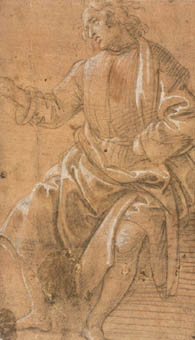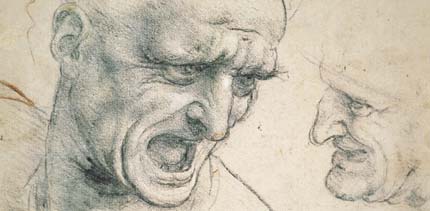Materials and Techniques (Drawing) 26-01-2004
Year 1: Introduction to Art History. Materials and Techniques 26 January 2004 Drawing
Slide 1: Leonardo Bust of a warrior (s/p c. 1470) (search Google for image)
Slide 2: Finiguerra? Seated youth drawing (p1w c. 1470) (search Google for image)
Slide 3: Filippo Lippi Drapery study (s/p c. 1450)
Filippino Lippi
Seated Man Raising His Right Arm
1485 – Metalpoint heightened with white on prepared paper – 170 x 99 m m
Filippino’s graphic oeuvre includes a large number of figure studies, both draped and nude. They are often drawn two or three to a sheet, but the figures are generally unrelated to one another and, in the past, many sheets have been dismembered in order to create self – sufficient drawings. These studies are almost always made in metalpoint with the addition of white body color on prepared paper. Filippino used different colors for his grounds: often blue, gray, or blue – gray but also light brown and salmon – pink. Few of his studies of this kind can be connected with specific projects, and it seems clear that he and members of his studio made them to practice the representation of the movements both of nude and draped figures and of the expressive potential of drapery forms. Filippino’s draperies are often of extraordinary complexity and vitality, and it is evident that he was fascinated by the activity of the inanimate, which can sometimes impart a wave – like motion to his compositions. Filippino, indeed, is one of great exponents of movement in the later quattrocento. But, unlike his master Botticelli, he employs it less for concentrated and explosive dramatic purposes than in the service of an all – pervading agitation. In this respect he anticipates elements of the later style of Giulio Romano, who was surely aware of, and responded to, this and other aspects of Filippino’s work.
The present drawing, however, is less complex in its pose and drapery forms than many of Filippino’s metalpoint figure studies. That may be the reason it was re- attributed by Berenson to Davide Ghirlandaio in 1903, although Gonse gave it to Filippino in 1877. It was returned to Filippino only in 1956, following an opinion expressed by Popham in a communication to the Mus'e de Lille in 1948. As noted by Goldner in 1997, it is very close in type and style to a drawing in Frankfurt (Fig. 4) that is similar in size, on paper prepared with a related if not identical color of ground, and looks to have been drawn from the same model. The two sheets could well have originated at the same session….
Slide 4: B. Gozzoli Study after the Dioscuri (s/p c. 1460) (search Google for image)
Slide 5: Filippino Lippi Nude studies (r) (s/p c. 1485) (search Google for image)
Slide 6: Filippino Lippi Nude studies (v) (sip c. 1485) (search Google for image)
Slide 7: Carpaccio Studies of three bishops (b/w c. 1490) (search Google for image)
Slide 8: Carpaccio St. Ursula meets the Pope (search Google for image)
Slide 9: Leonardo studies for Sforza horse (s/p c. 1485) (search Google for image)
Slide 10: Leonardo study for Sforza horse (s/p c. 1485) (search Google for image)
Slide 11: Filippino Lippi Study for litter-bearer (s/p c. 1490) (search Google for image)
Slide 12: Raphael study for soldier in Battle o,tOstia (s/p c. 1514) (search Google for image)
Slide 13: Ghirlandaio Head of a Woman (bl.ch. c. 1490) (search Google for image)
Slide 14: Ghirlandaio Head of a girl (s/p c. 1485) (search Google for image)
Slide 15: Carpaccio Head of a youth (b/w c. 1495) (search Google for image)
Slide 16: Pollaiuolo Hercules & Hydra (p/i c. 1460) (search Google for image)
Slide 17: Filippino Lippi Study of a running man (s/p c. 1485) (search Google for image)
Slide 18: Lombard c. 1400: Leopards (p/we c. 1400) (search Google for image)
Slide 19: Giovannino de Grassi Leopards (p/wc c. 1395) (search Google for image)
Slide 20: Pisanello Study of a cheetah (p/wc c. 1430) (search Google for image)
Slide 21: Pisanello Head of a horse (p/i c. 1435) (search Google for image)
Slide 22: Pisanello Sketch of a horse (p/i c. 1440) (search Google for image)
Slide 23: Pisanello Peacock & monkeys (p/i c. 1445) (search Google for image)
Slide 24: Pollaiuolo Nude youth (p/i c. 1475) (search Google for image)
Slide 25: Mantegna Flagellation studies (p/i c. 1465) (search Google for image)
Slide 26: Leonardo Adoration figures (p/i c. 1480) (search Google for image)
Slide 27: Raphael Resurrection study (p/i c. 1512) (search Google for image)
Slide 28: Raphael Annunciation cartoon (p/w c. 1502) (search Google for image)
Slide 29: Raphael Annunciation (Rome, Vatican; 1502) (search Google for image)
Slide 30: Leonardo Studies of the male shoulder (p/i c. 1510) (search Google for image)
Slide 31: Leonardo Study of a skull (p/i 1489) (search Google for image)
Slide 32: Rembrandt Winter landscape (rp/i c. 1650) (search Google for image)
Slide 33: Tiepolo Three river gods (p/w c. 1750 (search Google for image)
Slide 34: Michelangelo Drapery study (p/i c. 1490) (search Google for image)
Slide 35: Michelangelo Nude from rear (p/i c. 1503) (search Google for image)
Slide 36: Michelangelo Study for Cascina figure (bl.ch, c. 1504) (search Google for image)
Slide 37: Michelangelo Study for Lybian Sibyl (rd.ch c. 1510)
Studies for the Libyan Sibyl (recto); Studies for the Libyan Sibyl and a Small Sketch for a Seated Figure (verso), 1508 – 12
Michelangelo Buonarroti (Italian, 1475 – 1564)
Italian
Red chalk (recto); charcoal or black chalk (verso); 11 3/8 x 8 7/16 in. (28.9 x 21.4 cm)
Purchase, Joseph Pulitzer Bequest, 1924 (24.197. 2)
Slide 38: Leonardo Study for Judas (rd.ch c. 1495) (search Google for image)
Slide 39: Rubens Study of a female nude (rd.ch c. 1620) (search Google for image)
Slide 40: Raphael Study of girl with a mirror (rd.ch c.1515) (search Google for image)
Slide 41: Watteau Studies of a female head (rd/bl.ch c. 1720) (search Google for image)
Slide 42: Leonardo Study for old warrior (bl.ch c. 1504)
Studies for the Heads of Two Soldiers in the Battle of Anghiari (detail). Leonardo da Vinci (Vinci, 1452 — Cloux, 1519). Charcoal, or soft black chalk; some traces of red chalk on left; 192 x 188 mm (7 9 / 16 x 7 7/16 in.). Sz'pm'v'szeti M'zeum, Budapest 1775. (Cat. no. 91).
Slide 43: Leonardo Study for young warrior (rd.ch c. 1504) (search Google for image)
Slide 44: Raphael Seated male nude (bl.ch c. 1512) (search Google for image)
Slide 45: Raphael Studies for two Apostles (bl.ch c. 1516) (search Google for image)
Slide 46: A. Carracci Study of a triton (bl.ch c. 1600) (search Google for image)
bl.ch black chalk b/w brush and wash p/i pen and ink p/w pen and wash p/wc pen and watercolour rd.ch red chalk rp/i reed-pen and ink s/p silverpoint on prepared surface (r) recto (v) verso
